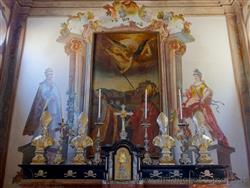|
Busto Arsizio (Varese, Italy): Church of San Gregorio Magno at the Cemetery
|
|
|
Show an other place around Milan worth a visit: |
 HISTORY HISTORY
The construction of the Church of San Gregorio Magno at the Cemetery (Church of San Gregorio Magno "al Camposanto") began immediately after the end of the Manzonian plague, in 1632, at the cemetery of the plague victims. Due to various interruptions, this original church, despite its small size, was only completed in 1659.
It consisted of a high square hall with a cross vault, a small sacristy on the left, a square presbytery with a barrel vault and a very simple two orders facade: on the sides two double and superimposed pilasters, a frame separating the two orders, main entrance in the center of the lower order, large rectangular window in the center of the upper one and a large pediment at the apex. Two other secundary entrances (now walled up) were present on the sides. It should be noted that the latters have, in the front half, the same layout as the facade, with double pilasters and the continuation of the cornice, that runs immediately under the roof.
In 1719 the bell tower and the right sacristy were added.
In 1742-1745 Biagio Bellotti enlarged the church, practically doubling its size. This was done by demolishing the back wall of the presbytery and adding a second rectangular hall with a pavilion vault and typically late Baroque mixtilinear windows.
In 1762 the stone staircase was built in front of the main entrance of the church and a lodging for the sacristan was created above the former presbytery.
The cemetery adjacent to the church remained in operation until 1893.
Between 1924 and 1926 the new sacristy was added behind the altar. The church was completely restored in the years 2010-2012.
STRUCTURE
The structure of the church reflects its history and the sequence of changes that have been made over time. It is therefore divided into two non-homogeneous blocks, with the frontal one, higher, corresponding to the older part, from the seventeenth century, and the rear one, lower and corresponding to the eighteenth century. Inside, the two parts are even divided by a narrower area, almost a corridor, corresponding to the presbytery of the original church.
The interior of the frontal part reflects the external structure, again with two pilasters on each side of the walls (with the corner pilaster in common for the pair of walls). With an almost Renaissance style, an arch which extends across the entire width of the wall to touch the pilasters is inserted on each wall. The cross vault is separated from the walls by a thick cornice. Immediately under the roof there are four windows (the one in the direction of the newer part of the church is only painted because, with the various modifications, it no longer had a reason to exist) inside stucco frames with a putto on each side and at the apex, instead of a cherub's head, a skull and two crossed femurs, testifying to the original function of the church as a cemetery church.
On the right wall hang the frescoes that once adorned the outside of the "mortorium" of the Basilica of St. John Baptist, works by the brothers Ambrogio, Giovanni and Biagio Bellotti (the latter grandfather of the homonymous painter from Busto). They are paintings dating from the late seventeenth century (1692) depicting images related to death. Others hang in the area that connects the two parts of the church. The left wall is instead occupied by the altar of the Virgin from the Church of Santa Maria. At the center of the vault there is a fresco Souls who are brought to Heaven by the angels, brought back to light only during the last restorations.
The eighteenth-century rear part is enriched by frescoes painted by Biagio Bellotti himself between 1742 and 1745: on the ceiling, inside a quadrature with plant motifs, the Ascent into heaven of a soul purged through the intercession of Charity, the suffrages of the Church and the individual prayer.
On the back wall are the Saints Clemente and Gemolo. Between them hangs the altarpiece, depicting San Gregorio and San Carlo witnesses of the end of the plague painted in 1618 by the brothers Giovan Francesco and Giovanni Battista Lampugnani. The altar frontal, which can be found, depending on the day, in front of the main altar or in front of that of the Virgin, depicts the Glory of San Gregorio Magno and was also made by Biagio Bellotti.
Categories: Places of historical value of artistic value
Via Giuseppe Mazzini, 21052 Busto Arsizio VA |
Further pictures of Church of San Gregorio Magno at the Cemetery in the section Photography |